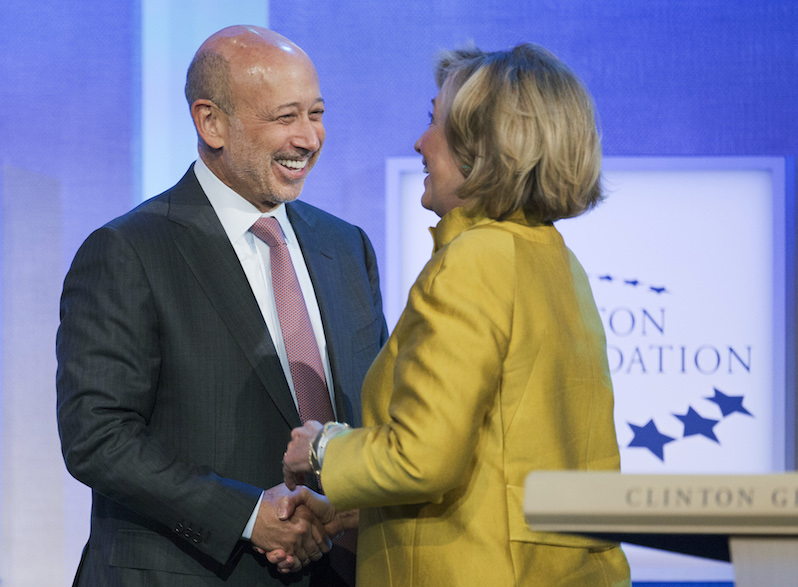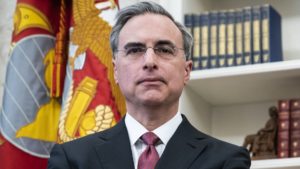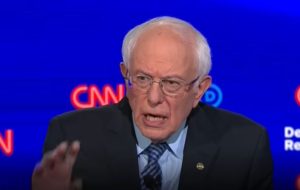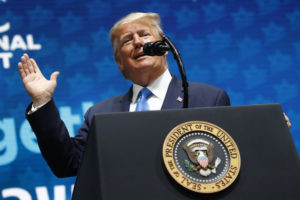It Takes a Ruling-Class Village to Staff the White House
Forget all the populist talk we've been hearing from Hillary Clinton and her cohorts, and follow the money to find out where the ruling elite's loyalties truly lie. Lloyd Blankfein, chairman and CEO of Goldman Sachs, is greeted by former Secretary of State Hillary Clinton at a panel discussion titled "Equality for Girls and Women: 2034 Instead of 2134?" The event was held by the Clinton Global Initiative in New York in September of 2014. (Mark Lennihan / AP)
1
2
3
Lloyd Blankfein, chairman and CEO of Goldman Sachs, is greeted by former Secretary of State Hillary Clinton at a panel discussion titled "Equality for Girls and Women: 2034 Instead of 2134?" The event was held by the Clinton Global Initiative in New York in September of 2014. (Mark Lennihan / AP)
1
2
3
The numbers get worse when you include GSMs who took such positions after they served in those presidencies. Broadened that way, the numbers for Clinton are 25 of 30 (83 percent) linked to 197 corporations and 27 of 30 (90 percent) linked to 157 companies for George W. Bush. By last year, seven former Obama GSMs had rotated back into top corporate roles after their White House stints.
The leading faction of capital represented in these GSM positions across the last three two-term presidencies is the financial sector and is overwhelmingly linked to “transnationally oriented capital.” Van Apeldoorn and de Graaff find that the “overall composition of the corporate background of these grand strategy makers” is “broad in terms of sectors,” with “U.S. transnationally oriented capital” in the lead and “the financial sector predominat[ing] among the corporate links of all three administrations.” Finance’s prevailing role indicates the global orientation of the Fortune 500 interests that hold sway in the U.S. presidency, “as financial capital is by definition more transnationally mobile than productive capital.” The legal and consultancy firms (e.g., Kissinger Associates) that have together provided more than a fifth of all GSMs since 1993 principally represent multinational corporations and investment firms.
Perhaps it is not entirely coincidental that the last three presidential administrations have overseen a significant loss of jobs and opportunity for the working-class majority in an ever more globalized New Gilded Age wherein the top 0.1 percent owns roughly as much wealth as the bottom 90 percent—an age of neoliberal austerity for the many, and vast governmental subsidy, protection and bailout for the wealthy few.
The Policy Planning Group Filter
The revolving door between top corporate/financial and government positions and the promise of heightened remuneration in the “private” sector (after one does Big Business’ bidding while “serving” in the “public” one) is a very big and often underestimated part of this overall system of class rule. Also unduly neglected is the role that elite neoliberal and corporate-financial-networked policy planning bodies play in staffing, socializing, solidifying and doctrinally schooling top U.S. executive branch personnel. The key institutions here are the CFR, The Trilateral Commission, the Bilderberg Group, the Rand Corp., The Aspen Institute, the Atlantic Council, the Brookings Institution, the Center for Strategic and International Studies, the Peterson Institute for International Economics, the Hoover Institution, the Carnegie Corporation of New York/Carnegie Endowment for International Peace, The Rockefeller Foundation, the Foreign Policy Association, the Committee for Economic Development and The Bretton Woods Committee.
These core policy organizations (with the CFR in the lead) share three basic properties: a strong commitment to the domestic and global “Open Door” expansion (non-territorial but not without considerable reliance on the U.S. and U.S.-sponsored military force) of American transnational “free market” capitalism (corporate, state and financial); principal funding by transnationally oriented Fortune 500 corporations and financial institutions; the ubiquitous presence of their top personnel both in the elite “private” (corporate, financial and legal) sector and in White House GSM positions.
Of Obama’s 30 GSMs, van Apeldoorn and de Graaff find, fully 25 (83 percent) held prior top affiliations with one or more of these planning groups, totaling 162 such affiliations. The elite policy groups’ presence was slightly higher in the Clinton White House (26/209) and similar in the Bush presidency (22/211).
Another part of the not-so-popular profile for those who become GSMs, supposedly planning domestic and foreign policy on behalf of “we the people” in the U.S. presidency, is training at one or more of the nation’s and world’s elite ruling-class universities, where neoliberal ideology and values prevail. Twenty-five of Obama’s (himself Harvard Law-pedigreed) first 38 Cabinet and top advisory picks had a degree from an Ivy League university, MIT, Stanford, the University of Chicago, Oxford or Cambridge.
“Lady Klynton Kissinger Sachs”
Will things be any different in the likely Clinton 45 White House? One would have to be very naive to think so. It’s not for nothing that Hillary Clinton is known on Wall Street as “Lady Klynton Kissinger Sachs.” The consistently war-hawkish Clinton is the quintessential power-elite and ruling-class insider. She was minted and socialized at such ruling-class institutions as Oxford, Yale Law, Rose Law, the Wal-Mart board of directors, the Democratic Leadership Council (dedicated to pushing the Democratic Party further to the corporate-friendly right during the 1980s and 1990s), the White House (eight years as a highly policy-empowered first lady), the globalist Clinton Foundation, the CFR and the U.S. State Department. She and her husband “operate in … a world awash in money and connections … [a] very privileged place,” as The New York Times’ Carolyn Ryan recently said. She is the candidate of campaign finance and of (exorbitant) speaking-fee choice for Goldman Sachs, Citigroup, the CFR, the Chicago Mercantile Exchange, Robert Rubin and the rest of the nation’s transnationally oriented corporate and financial aristocracy—including a remarkable number of pinstripe Republicans who do not trust the “unhinged” Trump. As New York Times columnist Maureen Dowd cleverly reflects:
SUPPORT TRUTHDIG
All these woebegone Republicans whining that they can’t rally behind their flawed candidate is crazy. The G.O.P. angst, the gnashing and wailing and searching for last-minute substitutes and exit strategies, is getting old. They already have a 1-percenter who will be totally fine in the Oval Office, someone they can trust to help Wall Street, boost the U.S. Chamber of Commerce, cuddle with hedge funds, secure the trade deals beloved by corporate America, seek guidance from Henry Kissinger and hawk it up. … The Republicans have their candidate: It’s Hillary.Personnel Is Policy But it’s not just about Hillary Clinton. It takes a ruling-class village to make policy for the few in the name of the many. Clinton’s vice presidential pick, Tim Kaine, is a financial-sector darling who backed fast-tracking the arch-global corporatist, Wall Street-backed Trans-Pacific Partnership (TPP). Her campaign manager, John Podesta, is a legendary ruling-class inside-outsider. A former chief of staff for President Bill Clinton, Podesta has headed a major Washington, D.C., lobbying firm whose clients have included BP, Citigroup, Wal-Mart and Lockheed Martin. He founded the Center for American Progress (CAP), which has become a virtual policy arm of the neoliberal Obama White House and—as The New York Times reported after Obama appointed him as a special adviser in December of 2013—“taken millions of dollars in corporate donations and has its own team of lobbyists who have pushed an agenda that sometimes echoes the interests of those corporate supporters.” The CAP poses as a “progressive,” even “left-leaning” alternative to right-wing think tanks like the Heritage Foundation, but it really embodies a kind of reconstructed “Third Way neoliberalism” that is deeply captive to global corporate and financial interests. Podesta is also president of the Clinton-Kaine Transition Project. Your support matters…
Independent journalism is under threat and overshadowed by heavily funded mainstream media.
You can help level the playing field. Become a member.
Your tax-deductible contribution keeps us digging beneath the headlines to give you thought-provoking, investigative reporting and analysis that unearths what's really happening- without compromise.
Give today to support our courageous, independent journalists.






You need to be a supporter to comment.
There are currently no responses to this article.
Be the first to respond.